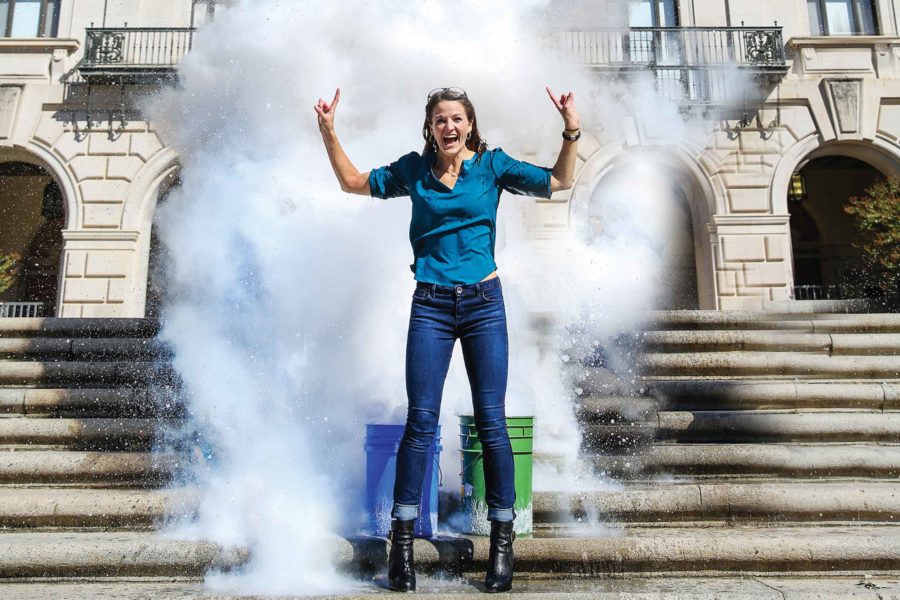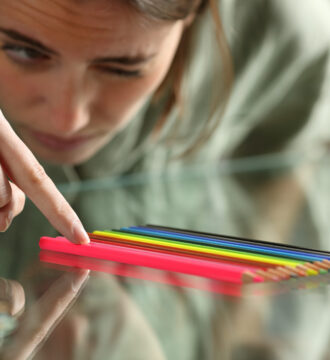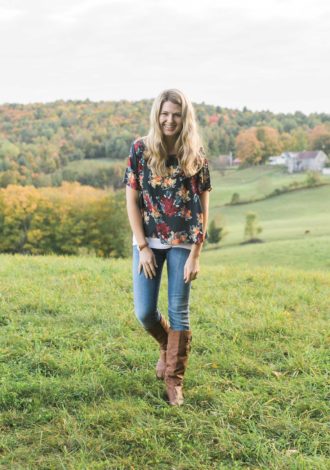Since earning her Ph.D. in inorganic chemistry in 2014, Dr. Kate Biberdorf has crafted the career of her dreams. In her “day job” at the University of Texas at Austin, she holds a dual role as professor—teaching two 500-student general chemistry courses—and director of demonstrations and outreach, bringing wacky, explosive “Fun with Chemistry” sessions to local K-12 classrooms.
In her other life, she is “Kate the Chemist,” appearing on local television programs and crisscrossing the nation as a science entertainer, breathing fire and blowing things up as often as she can. National TV appearances have included “The Wendy Williams Show” and “The Late Show with Stephen Colbert.” Her grand finale often involves dumping hot water into liquid nitrogen to create an immense “thunder cloud” that fills the room, thrilling audiences and hosts alike.
“I get to play with fire and blow things up. I love my job!” Biberdorf tells Exhale. “I’m very tired all the time, but it’s so worth it.”
“Dr. B” does it all with style, delivering lectures wearing one of her 40 or so pencil skirts along with a pair of killer heels—purple ones for certain favorite lessons. When things get really messy, she pulls her long hair back and dons a blue lab coat and waterproof boots. “I can spill liquid nitrogen on them, but they’re super-feminine,” she says of the high-heeled boots.
Besides the fun and fire, Biberdorf has a mission to publicize women in STEM fields and inspire the next generation, well aware of the role of chemistry in looming global challenges like trapping carbon and developing alternative fuels. In April, she visits Boston to unveil a brand-new “Women in STEM” presentation at the Simmons Leadership Conference. Her talk pairs stories of unsung women science achievers with, of course, explosions.
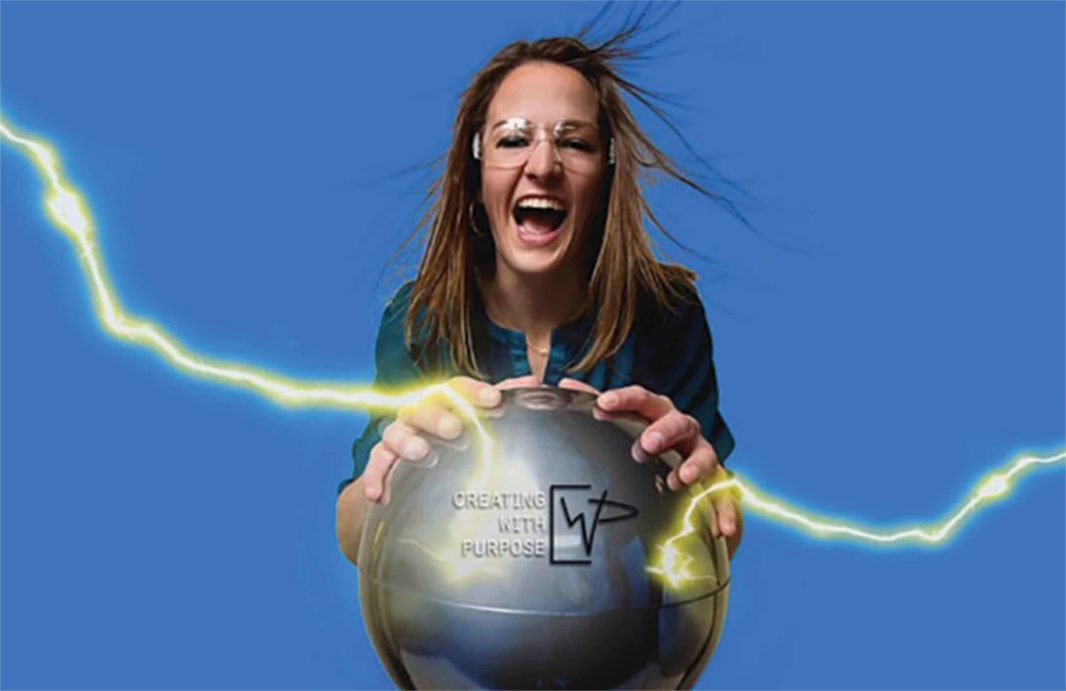
PHILIP ADCOCK FROM CREATING WITH PURPOSE
Dr. Kate Biberdorf sparks an interest in chemistry — and STEM — among young women.
The Science Kid
From early childhood, the Kalamazoo, Michigan, native liked to break things apart and see how they went together. She recalls that at five or six years old, already highly active and brimming with curiosity, she conducted experiments with household items alongside her little sister. “My mother allowed us to ‘play scientist.’ She basically cleared a bathroom and put only safe things in there. We would take shampoo and conditioner and everything else and mix it all together.”
In high school, she had a dynamic female chemistry teacher, Mrs. Palsrok, and the die was cast. “Ever since I was 15, I knew I wanted to be a chemist,” Biberdorf says. “Her energy was just so contagious. She made it fun, but she was a brilliant woman.”
Now, at 32, Biberdorf hasn’t lost a shred of her early excitement for experimenting. Juggling a dizzying schedule of air travel, teaching and entertaining, the high-energy professor relishes fostering that open-eyed wonder in as many people as possible.
Generating an emotional response, says Biberdorf, opens children’s minds to learning and makes them more likely to remember the scientific explanation that comes next. “After the experiments, I have a 60-second window to shove information in,” she says, only half-joking. With college students, that window is longer. Still, she finds they are far more engaged when she includes at least one lively demonstration per class.
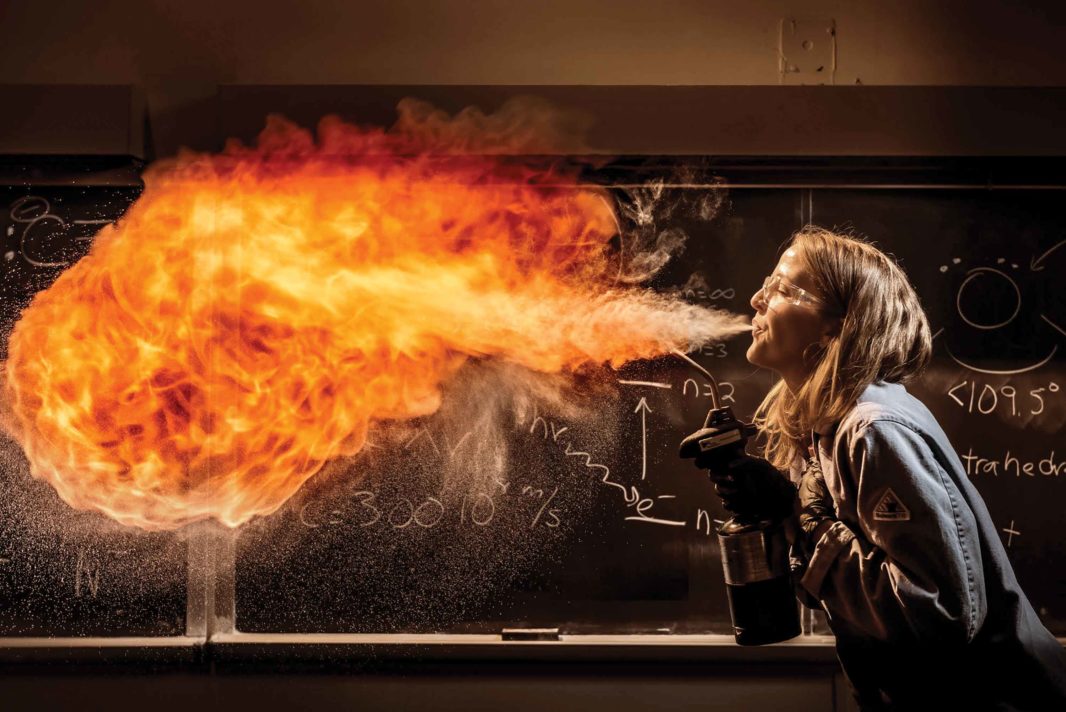
Courtesy Kate Biberdorf
Dr. Kate Biberdorf uses demonstrations as a way to make chemistry cool for people of all ages.
Positive Energy
As a female science graduate student, she had to fight, at times, to be taken seriously. In order to hold her own in a room full of academics, mostly men, she felt pressure to curtail her natural bubbly demeanor. Over time, she has grown better at this balancing act, she says. “I’ve learned how to do that and remain true to my authentic self. It’s OK to be both bubbly and a smart person.” Whether on TV or in academic settings, she concludes, “I’m going to be myself. You’re going to love it or hate it, but hopefully people see that I love who I am.”
With few female mentors through her college and post-college years, she navigated the tricky terrain mostly on her own.
“Here’s what I did: I kept my head down, made sure I was the strongest student I could possibly be. But, when [it comes to] touching my body or commenting on my body, I will speak up. I will say that’s inappropriate. I stare back and wait. I make it clear I will not tolerate it.”
She looks for chances to reach back and empower younger women. “It’s important to be honest,” she advises. “Someone is going to make a comment about how you look, and how that suggests you’re not smart. You will experience it, and please don’t give up.”
If science Ph.D. programs have been traditionally a man’s world, science entertaining may be even more so. Growing up, the future chemist watched “Bill Nye The Science Guy,” but she never saw women scientists on TV.
Biberdorf hopes to shatter that mold, using her public science presence to demonstrate that “You can be a girl who likes fire and explosions … and you don’t have to be that stereotypical nerd with the bowtie. You can just be a scientist.”
Having the courage to be herself makes her a natural as a featured member of Amy Poehler’s Smart Girls, an organization dedicated to helping young people be confident with their “weird and wonderful selves.”
Room for Dreams
In her downtime, Biberdorf looks forward to spending time with her husband, Josh, a software engineer (and a great cook) who stays closer to home, and their dogs. When she’s home, her secret hobby is baking, particularly pies and soft pretzels. “There’s a lot of chemistry in baking,” she notes.
But, as her students and audiences might easily guess, she can’t stay still for long. “I work out a lot,” she says, “and I just bought a skateboard, so I’m learning to maneuver on it. It’ll save me so much time on campus!”
Her current life suits her fabulously, but there’s still room for dreams. She envisions bringing a science show to Las Vegas someday. Besides including even bigger and more dramatic explosions, she says, “It would be so cool to see a culture shift where people would want to see a science show, where they would find it worth their evening on a vacation to see this scientist blow stuff up and explain it.”
Reflecting on the upcoming Simmons Leadership Conference, she says, “I want to build a ‘STEM army of women.’ The way you do that is by speaking about other women’s work.” She feels there’s no better venue for this than a conference of 3,400 of the best and brightest women out there. “I’m going to give them everything I can about women and STEM, so they have that in their arsenal,” she says. “I can’t do this by myself—I need people talking about science and encouraging other women.”
And the explosions? “They do illustrate my point,” she says. “It all loops together. But let’s be clear—I want to be the best show there. I’m not going to boil water!”



 6 min read
6 min read